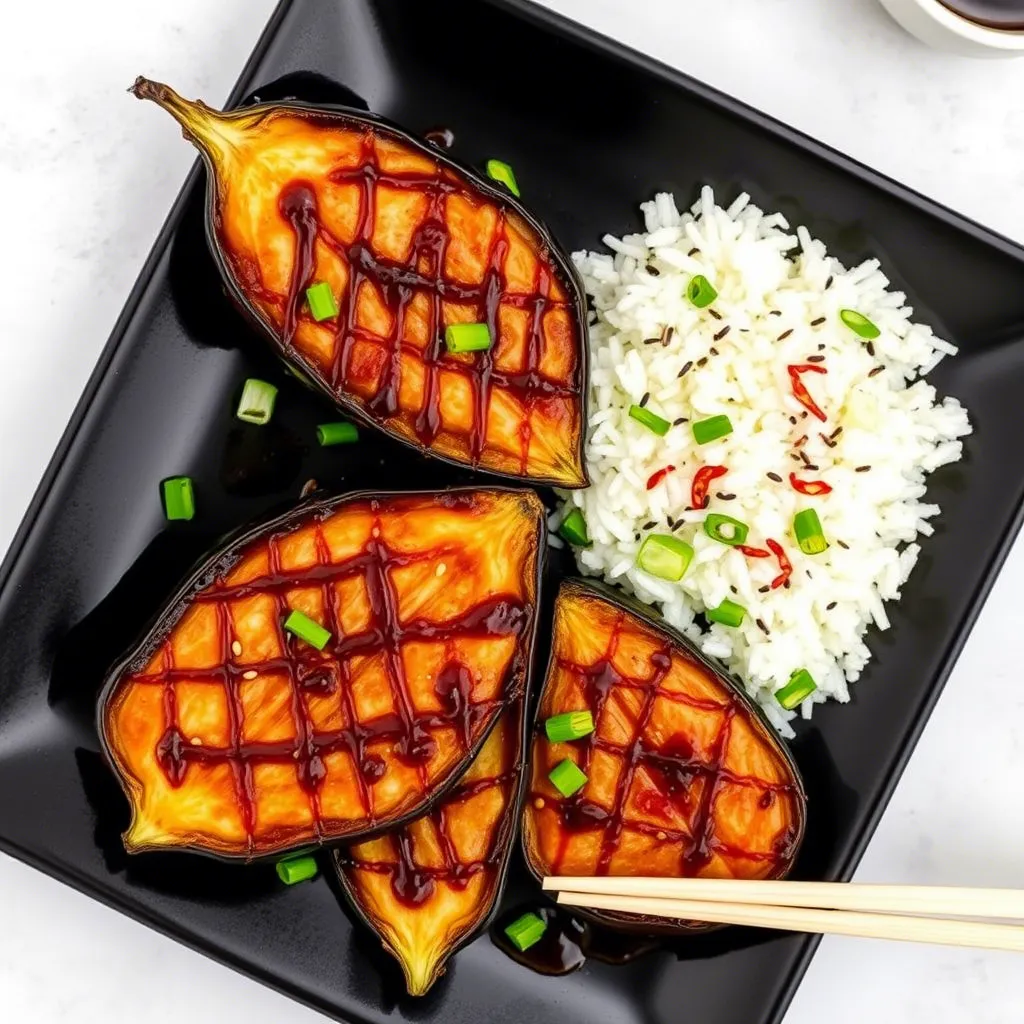There’s something magical about the way miso transforms an everyday vegetable into something extraordinary. The first time I tasted miso glazed eggplant at a tiny Tokyo restaurant, I was struck by how such a humble ingredient could become the star of the meal. That’s the beauty of this miso eggplant recipe – it takes something simple and elevates it to restaurant-quality with minimal effort. The sweet-savory glaze caramelizes to create a dish that’s impressive enough for guests but easy enough for a Tuesday night dinner.
Why You’ll Love This Miso Glazed Eggplant
If you’ve ever struggled to get your family excited about vegetables, this miso eggplant will be your new secret weapon. The umami-rich miso glaze creates a flavor that’s absolutely irresistible – slightly sweet, deeply savory, and with that perfect caramelized edge that makes you want to scrape every last bit from the plate.
As a busy home cook myself, I know the dinner struggle is real. Between work deadlines, kids’ activities, and the eternal question of “what’s for dinner?” that somehow needs answering every single day, we need recipes that deliver major flavor without major effort. This dish hits that sweet spot perfectly. The hands-on time is minimal, and while the eggplant roasts, you can prepare the sesame rice or handle those other household tasks that are calling your name.
What I particularly love about this miso eggplant is its versatility. Served with the sesame rice, it becomes a satisfying main dish for Meatless Monday. Add it to your spread of homemade fish tacos for an unexpected twist, or serve it alongside grilled chicken for a more substantial meal. The leftovers (if there are any!) taste amazing cold the next day tucked into a wrap with some crunchy vegetables.
The contrasting textures make this dish especially satisfying – the eggplant becomes velvety and tender while the edges get wonderfully caramelized, and the sesame rice adds a perfect nutty crunch. It’s a combination that makes your taste buds dance and transforms an ordinary weeknight into something special.
For those busy moms and working professionals among you, this recipe is also a meal-prep champion. You can prepare the miso glaze up to three days ahead and keep it in the fridge. The eggplant can be sliced and ready to go, making dinner assembly quick and painless when you walk through the door after a long day.
And let’s talk about the nutritional benefits – eggplant is rich in antioxidants, fiber, and vitamins, while miso brings beneficial probiotics to the table. It’s one of those rare dishes where “delicious” and “nutritious” truly go hand in hand. In our house, we call these kinds of recipes “wins all around” – they satisfy my desire to feed my family well, my husband’s taste for bold flavors, and the kids’ very vocal opinions about what constitutes an acceptable dinner.
Health-conscious eaters will appreciate that this dish delivers big flavor without relying on excessive oil or salt. The miso paste packs such a flavor punch that you don’t need much else to create something memorable. It’s a beautiful example of how Japanese cuisine often creates impactful flavors with surprisingly few ingredients.
The Story Behind This Miso Glazed Eggplant
The sound of sizzling eggplant and the sweet-savory aroma of miso glaze caramelizing in the oven instantly transports me back to my tiny apartment kitchen in my twenties. I was a culinary school dropout with big dreams and an even bigger appetite for global flavors, determined to recreate the dishes I’d fallen in love with during my travels.
Japanese cuisine always held a special place in my heart, particularly because of how it transformed vegetables into the main attraction rather than relegating them to side dish status. This miso eggplant became my personal obsession after tasting it at a small family-owned restaurant during a trip to Japan. The chef, a kind-eyed woman probably in her seventies, noticed my enthusiasm and invited me into her kitchen the following day.
She spoke very little English, and my Japanese was limited to “thank you” and “delicious,” but cooking transcends language barriers. Through gesture and demonstration, she showed me how to select the perfect eggplant (firm but yielding slightly to pressure) and the importance of scoring the flesh to help it absorb the flavorful glaze. Most importantly, she taught me patience – allowing the natural sugars in the miso to caramelize slowly, creating that perfect balance of sweet and savory.
When I returned home, I was determined to recreate that magical dish. My first attempts were…educational, to put it kindly. Too much miso made it overwhelmingly salty; too little created a bland disappointment. The eggplant would sometimes emerge from the oven sad and soggy rather than silky and caramelized.
But persistence pays off. After numerous attempts and adaptations, this recipe emerged as the perfect balance – simple enough for weeknight cooking but special enough to evoke those memories of Japan. Now it’s in regular rotation at our house, requested at least monthly by my youngest, who claims the caramelized edges as her special treat.
The addition of sesame rice wasn’t part of the original dish I learned, but it evolved naturally in my kitchen. The nutty crunch of toasted sesame seeds and the subtle hint of rice vinegar create the perfect canvas for the glazed eggplant. Together, they make a complete meal that feels both nourishing and a little bit special – the culinary equivalent of putting on your favorite comfortable dress that somehow also makes you feel fantastic.
This dish has become our family’s comfort food with a twist. On rainy evenings when everyone’s a little cranky and the day has gone sideways, I’ll often reach for this recipe. By the time we sit down to eat, the kitchen smells amazing, and the mood has lifted. Food has that power – to transform not just ingredients but moments and memories.
Last summer, my daughter’s friend stayed for dinner on miso eggplant night. She eyed the purple vegetable suspiciously (as kids often do with unfamiliar foods), but after one hesitant bite, she was converted. Her mother texted me the next day asking for the recipe because her daughter had declared it “the best vegetable ever.” That’s when you know you’ve got a winner on your hands.
What I love most about sharing this recipe is knowing it might become part of your family’s story too. Perhaps it will be your gateway into exploring more Japanese flavors, or maybe it will simply be the dish that finally convinces a skeptical family member that eggplant can indeed be delicious. Either way, it carries forward that beautiful tradition of food as connection – between cultures, generations, and the people gathered around your table.
Ingredients
Let’s gather everything we need for this flavor-packed miso glazed eggplant with sesame rice. The beauty of this recipe lies in its relatively short ingredient list that delivers maximum impact.
For the Miso Glazed Eggplant:
- 2 large eggplants (look for firm, glossy ones with smooth skin)
- 3 tablespoons white miso paste (the milder flavor works beautifully here)
- 2 tablespoons mirin (Japanese sweet rice wine)
- 1 tablespoon rice vinegar
- 1 tablespoon honey (or maple syrup for a vegan option)
- 1 tablespoon toasted sesame oil
- 1 tablespoon low-sodium soy sauce (or tamari for gluten-free)
- 2 cloves garlic, finely minced
- 1 tablespoon fresh ginger, grated
- 2 tablespoons neutral oil like grapeseed or canola, for brushing
- 2 green onions, thinly sliced for garnish
- 1 tablespoon toasted sesame seeds, for garnish
For the Sesame Rice:
- 2 cups short-grain Japanese rice (or substitute medium-grain rice)
- 2½ cups water
- 1 tablespoon rice vinegar
- 1 teaspoon sugar
- ½ teaspoon salt
- 2 tablespoons toasted sesame seeds
- 1 tablespoon toasted sesame oil
Let’s talk about these ingredients, because understanding them helps you make this dish truly shine. Eggplant is the star here, and while any variety will work, I prefer the classic globe eggplants for their meaty texture and ability to absorb flavors. If you can find Japanese eggplants (the long, thin variety), they’re also excellent and cook a bit faster.
Miso paste is our flavor powerhouse. It’s a fermented soybean paste that brings incredible umami depth to the glaze. White miso (also called shiro miso) has a more delicate, sweet flavor compared to darker varieties, making it perfect for our glaze. You can find it in the refrigerated section of most grocery stores, Asian markets, or health food stores. Once opened, it keeps for months in the refrigerator, so don’t worry about buying a container for just one recipe – you’ll find yourself reaching for it again and again to add depth to soups, dressings, and marinades.
Mirin and rice vinegar might seem similar, but they play different roles. Mirin adds sweetness with subtle alcohol notes that help tenderize the eggplant, while rice vinegar brings brightness and acidity to balance the rich miso. If you can’t find mirin, you can substitute 1 tablespoon sake or dry white wine plus 1 teaspoon sugar.
The honey in our glaze helps create that beautiful caramelization we’re looking for. The slight floral notes complement the eggplant perfectly, but maple syrup works beautifully too if you prefer a vegan option.
For the rice, I strongly recommend short-grain Japanese varieties like Koshihikari if you can find them. Their slightly sticky texture creates the perfect base for our dish. If those aren’t available, any medium-grain rice will work well too. The seasoning we add – rice vinegar, sugar, and salt – is inspired by traditional sushi rice preparation and gives the rice a beautiful flavor that complements our glazed eggplant.
Substitutions are the home cook’s best friend, so let’s talk options. If you’re soy-free, coconut aminos make a great substitute for soy sauce. No fresh ginger on hand? In a pinch, ¼ teaspoon of ground ginger can work, though the flavor won’t be quite as vibrant. For a spicier version, add a teaspoon of gochujang (Korean chili paste) or a sprinkle of red pepper flakes to the glaze.
Don’t be intimidated by any unfamiliar ingredients – they’re worth seeking out for this dish, and once they’re in your pantry, you’ll discover countless ways to use them. My homemade zuppa toscana recipe might seem worlds away from Japanese cuisine, but the same principles apply – quality ingredients treated with respect create memorable meals.
Execution
Preparing this stunning miso glazed eggplant is surprisingly straightforward. The key is to allow adequate time for the eggplant to roast and caramelize properly – this isn’t a dish to rush. Let’s break it down step-by-step:
Step 1: Prepare the Rice (20 minutes)
- Rinse the rice in cold water until the water runs almost clear, about 3-4 changes of water.
- Place the rinsed rice and 2½ cups water in a medium saucepan. Let it soak for 10 minutes if you have time – this helps the grains cook more evenly.
- Bring to a boil over medium-high heat, then reduce heat to low, cover, and simmer for 15 minutes.
- Remove from heat but keep covered – let the rice rest for an additional 10 minutes. This resting period is crucial for perfectly textured rice.
- Meanwhile, in a small bowl, whisk together rice vinegar, sugar, and salt until dissolved.
- When the rice has rested, transfer it to a large bowl and gently fold in the vinegar mixture, sesame seeds, and sesame oil with a rice paddle or wide spoon, using a cutting motion to avoid smashing the grains. The rice should be shiny and well-separated.
- Cover with a clean kitchen towel until ready to serve.
Step 2: Prepare the Eggplant (5 minutes)
- Preheat your oven to 425°F (220°C) and line a large baking sheet with parchment paper.
- Cut the eggplants in half lengthwise, then score the flesh in a diamond pattern about ½-inch deep. Be careful not to cut through the skin.
- Brush each cut surface liberally with neutral oil.
- Place the eggplant halves cut-side down on the prepared baking sheet and roast for 20 minutes, until the flesh begins to soften.
Step 3: Prepare the Miso Glaze (5 minutes)
- While the eggplant is roasting, combine miso paste, mirin, rice vinegar, honey, sesame oil, soy sauce, minced garlic, and grated ginger in a small bowl.
- Whisk until smooth and well combined. The consistency should be like a thick, pourable sauce – if it’s too thick, add a teaspoon of warm water.
Step 4: Glaze and Finish the Eggplant (10 minutes)
- After the initial 20 minutes of roasting, remove the eggplant from the oven and carefully flip each half so the cut side is facing up.
- Generously brush the miso glaze over the scored flesh, making sure to get some into the cuts you made.
- Return to the oven and roast for an additional 10-15 minutes, until the glaze is caramelized and bubbling, and the eggplant is completely tender when pierced with a fork.
- If you’d like more caramelization, switch the oven to broil for the final 2 minutes, watching carefully to prevent burning.
Step 5: Serve (5 minutes)
- Scoop the sesame rice onto serving plates or a large platter.
- Arrange the glazed eggplant halves on top or alongside the rice.
- Garnish with sliced green onions and an extra sprinkle of toasted sesame seeds.
- For an extra touch of flavor, drizzle with a small amount of additional sesame oil.
The visual cues are important for this recipe. You’ll know the eggplant is properly cooked when the flesh can be easily pierced with a fork but still holds its shape. The glaze should be caramelized and bubbling, with some darker spots where it’s becoming deliciously sticky.
If you’re making this as part of a larger meal, time it so that the eggplant comes out of the oven just before serving – it’s at its most magnificent when fresh from the oven with the glaze still sizzling. The sesame rice can hold at room temperature, covered, for up to an hour.
As noted by food scientists at Serious Eats, salting eggplant before cooking is often unnecessary with modern eggplant varieties, which have been bred to be less bitter. However, if your eggplants are particularly large or you detect any bitterness when you cut them, you can salt the cut surfaces and let them sit for 30 minutes, then pat dry before proceeding with the recipe.
When serving, I like to present the eggplant halves whole – they make for a stunning presentation – but feel free to slice them into portions if that’s more practical for your gathering. Either way, make sure everyone gets some of that beautifully caramelized edge – that’s the cook’s equivalent of culinary gold!
Additional Tips
The beauty of home cooking lies in making recipes your own, and this miso glazed eggplant is incredibly adaptable. Here are some of my favorite tips and variations to help you get the most out of this dish:
Perfect Your Eggplant Selection: When shopping for eggplants, look for ones that feel heavy for their size with smooth, shiny skin. A fresh eggplant should have a bright green stem and feel firm but not hard when gently squeezed. Small to medium eggplants often have fewer seeds and a more tender texture than very large ones.
Make It a Meal Prep Star: This dish works beautifully for meal prep with a few adjustments. Prepare the miso glaze up to 5 days ahead and store in an airtight container in the refrigerator. You can pre-score the eggplant the day before and store it in the refrigerator with cut sides brushed lightly with lemon juice to prevent browning. The sesame rice can be made a day ahead – just reheat it with a sprinkle of water in the microwave or on the stovetop.
Transform It Into a Grain Bowl: For a trendy twist, serve smaller portions of the glazed eggplant over a mix of sesame rice and quinoa, then add edamame, sliced avocado, quick-pickled cucumbers, and a sprinkle of furikake (Japanese seaweed and sesame seed seasoning). This makes the dish stretch further and adds wonderful textural contrast.
Don’t Fear the Broiler: That final minute or two under the broiler is what creates the irresistible caramelization on the miso glaze. Just keep a close eye on it – the difference between perfectly caramelized and burnt can be a matter of seconds.
Wine Pairing Suggestions: The sweet-savory profile of this dish pairs beautifully with an off-dry Riesling, whose slight sweetness complements the caramelization while the acidity cuts through the richness. If you prefer red, reach for a light Pinot Noir with minimal tannins. For a non-alcoholic option, a jasmine green tea or sparkling yuzu drink makes a refreshing companion.
Add Protein: To make this dish even more substantial, top with crispy tofu, a soft-boiled egg, or flaked grilled salmon. The miso glaze complements each of these proteins beautifully.
Go Seasonal: While this recipe is wonderful year-round, during summer months when eggplants are at their peak, try grilling them instead of roasting for a smoky dimension. In cooler months, roast some mushrooms alongside the eggplant during the final cooking phase for an earthier version.
Consider Your Cookware: A light-colored baking sheet works best for this recipe as dark pans can cause the bottoms to brown too quickly before the eggplant is fully tender. If you only have dark baking sheets, reduce the oven temperature by 25°F and add a few minutes to the cooking time.
Get Creative with Leftovers: If you’re lucky enough to have leftovers, they transform magically into next-day delights. Chop the glazed eggplant and fold it into scrambled eggs with a sprinkle of goat cheese for breakfast, or stuff it into a wrap with hummus and fresh greens for lunch.
Heat Level Adjustments: As written, this recipe has just a whisper of heat from the ginger and garlic. If you enjoy spice, add a thinly sliced red chili to the glaze or finish the dish with a sprinkle of shichimi togarashi (Japanese seven-spice blend).
Mindful Miso: Different brands of miso can vary significantly in saltiness. If you’re using a brand for the first time, start with the smaller amount of soy sauce in the glaze, then taste and adjust.
Kid-Friendly Adaptation: If cooking for little ones who might be skeptical of eggplant, try slicing it into rounds instead of halves. The increased surface area creates more caramelization, and the smaller pieces are less intimidating on a child’s plate.
As with all recipes, the most important ingredient is confidence. Trust your instincts as you cook, taste as you go, and remember that perfection isn’t the goal – creating food that brings joy to your table is what truly matters. Some of my favorite cooking memories come from happy accidents and improvisations that became new family favorites.
FAQs
Q: Can I make this recipe with different types of eggplant?
A: Absolutely! While globe eggplants work beautifully, Japanese eggplants, fairy tale eggplants, or even graffiti eggplants are wonderful substitutes. Just adjust cooking times accordingly – smaller varieties will cook more quickly. The long, thin Japanese eggplants are particularly good for this recipe as they cook faster and have a tender texture with fewer seeds.
Q: I can’t find white miso paste. Can I substitute another type?
A: Yes, though it will change the flavor profile slightly. Yellow miso (awase) has a bit stronger flavor but works well. Red or brown miso paste will give you a more robust, intensely savory result – if using these darker varieties, reduce the amount to 2 tablespoons to prevent the dish from becoming too salty, and you might want to increase the honey to 1½ tablespoons to balance the stronger flavor.
Q: How do I store leftovers?
A: Allow any leftover eggplant to cool completely, then store in an airtight container in the refrigerator for up to 3 days. The sesame rice can be refrigerated separately for up to 5 days. For best results when reheating the eggplant, use a 350°F oven for about 10 minutes rather than the microwave to help preserve the texture.
Q: Is this recipe gluten-free?
A: Not as written, since traditional soy sauce contains wheat. However, it’s easily adapted to be gluten-free by substituting tamari for the soy sauce and checking that your miso paste is certified gluten-free (most are naturally gluten-free, but some may contain barley).
Q: My miso glaze is too thick to spread easily. What should I do?
A: Simply thin it with a teaspoon or two of warm water until it reaches a consistency that spreads easily but isn’t runny. Different brands of miso paste can vary in moisture content, so this adjustment may be necessary.
Q: Can I freeze this dish?
A: The eggplant can be frozen after cooking, but the texture will soften significantly upon thawing. I’d recommend enjoying it fresh for the best experience. However, the miso glaze itself freezes beautifully in an ice cube tray for up to 3 months – pop out a cube whenever you need a quick flavor boost for vegetables or proteins.
Q: What can I do with the leftover miso paste?
A: Miso paste is incredibly versatile! Use it to make quick soup bases, salad dressings, marinades for fish or chicken, or whisk a teaspoon into melted butter to brush on corn on the cob. It keeps for months in the refrigerator, so there’s plenty of time to experiment.
Q: Do I really need to score the eggplant?
A: While not absolutely essential, scoring serves two important purposes: it helps the eggplant cook more evenly and creates more surface area for the delicious glaze to cling to. Those little pockets of glazed goodness are often the best bites!
Q: Can I make this with less oil to reduce calories?
A: Yes, you can reduce the oil somewhat. Rather than brushing the cut surfaces, you can use an oil spray to coat them lightly. Keep in mind that eggplant does tend to absorb oil, and some fat helps carry the flavors. Another technique is to “steam-bake” the eggplant first: place the scored halves cut-side down on the baking sheet, add 2 tablespoons water to the pan, and cover tightly with foil for the first 15 minutes of baking. Then proceed with the glaze as directed.
Q: What’s the best way to toast sesame seeds?
A: The easiest method is to place raw sesame seeds in a dry skillet over medium-low heat. Shake the pan frequently and watch them carefully – they go from perfectly golden to burnt very quickly, usually in 3-5 minutes. You’ll know they’re ready when they’re golden brown and fragrant. Alternatively, spread them on a baking sheet and toast in a 350°F oven for about 5-7 minutes, stirring halfway through.
This miso glazed eggplant with sesame rice has become a cherished recipe in my kitchen, one that bridges the gap between everyday cooking and something special. I hope it finds a similar place in your culinary repertoire, bringing a taste of Japanese-inspired flavors to your table with minimal fuss and maximum satisfaction. Happy cooking!



